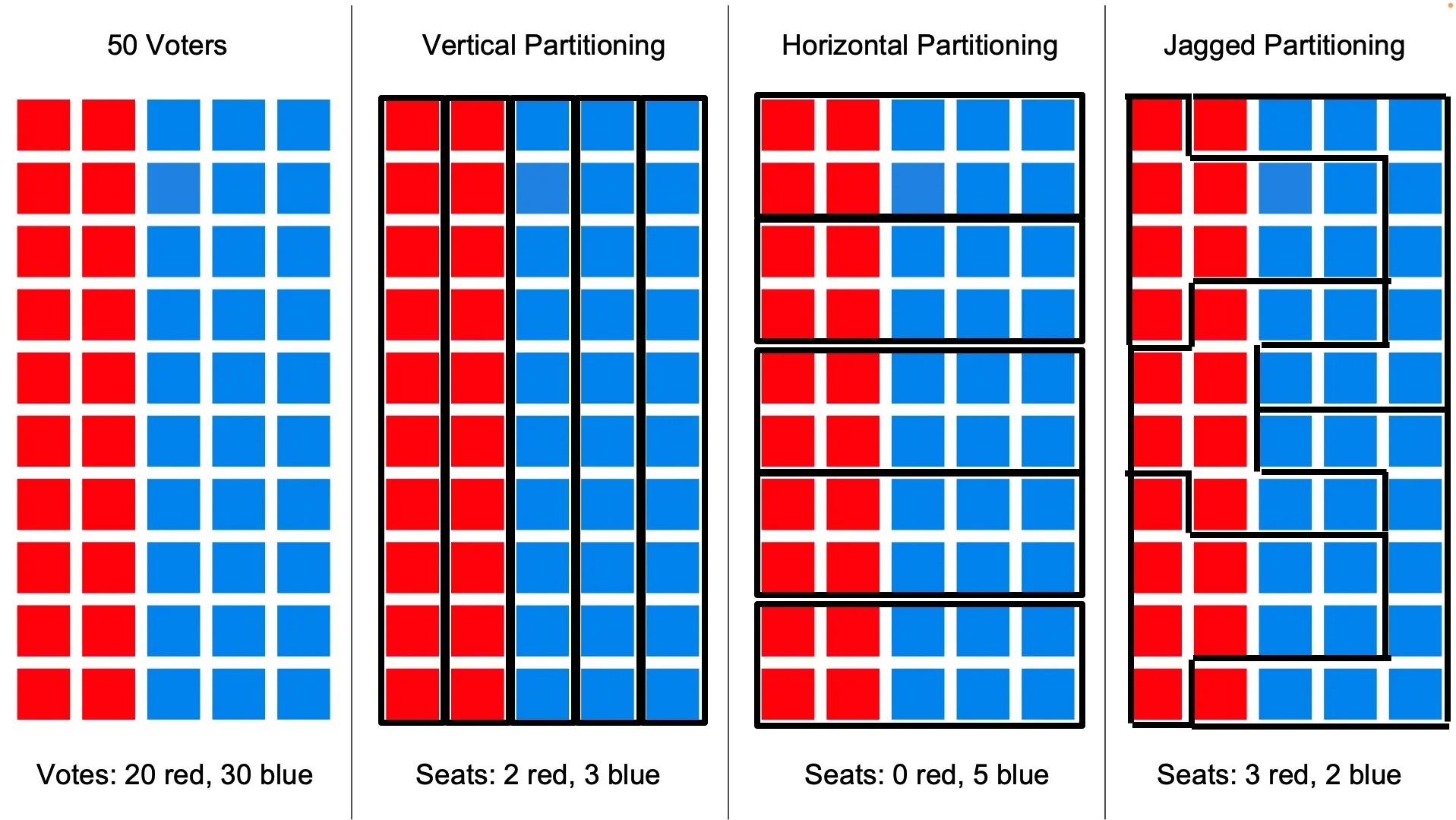The Texas Legislature Wants to Take Away Your Representation in Congress
Governor Abbott wants to use the special legislative session to make sure Black and brown communities have even less representation in Congress than they already do. We have to resist that by any means necessary. Contact your state legislator to express your opposition to any redistricting at this time!
Background
Earlier this summer, Texas Governor Greg Abbott called a special session of the State Legislature. The Governor of Texas has the power to call the Legislature into special session, and to spell out the agenda for that session. Many Texas residents hoped that Governor Abbott would use the special session to address what went wrong during the devastating July 4 floods in the Texas Hill Country, which resulted in the loss of more than one hundred lives. Instead, at the behest of President Trump, and in collaboration with Lieutenant Governor Dan Patrick and Speaker of the Texas House Dustin Burrows, the Governor has promoted a substantial rearrangement, or redistricting, of US Congress members who represent Texas. This is happening under a Special Session bill, House Bill 4.
Redistricting is not necessarily a bad thing. The federal government conducts a national census every 10 years (in years ending in zero), in part to make sure that every congressional district represents a roughly equal number of people. People naturally move from place to place, so some districts grow in population and others shrink. Every state legislature has a duty to adjust congressional districts based on these natural shifts in population.
Redistricting is intended to ensure fair and equitable representation in Congress. However, in practice, some redistricting efforts can result in the manipulation of district boundaries in ways that dilute the voting strength of certain communities. This practice, known as gerrymandering, often involves dividing neighborhoods, especially those with high concentrations of Black, Latino, low-income, and working-class residents, into multiple districts, weakening their collective voting power.
Critics argue that such redistricting practices can entrench political power by enabling elected officials to shape districts in ways that favor one party over another, potentially undermining the principle that voters should choose their representatives, not the other way around. Ensuring transparent, community-centered redistricting processes is essential to a healthy democracy.
The current redistricting proposals in Texas raise concerns about equitable representation. Some advocates and researchers have pointed out that these changes may disproportionately benefit wealthier, predominantly white communities, while diluting the voting strength of lower-income and racially diverse populations.
At the same time, recent federal budget decisions have prioritized increased funding for agencies like the Department of Homeland Security (DHS), which includes Immigration and Customs Enforcement (ICE), while reducing investments in programs such as Medicaid and SNAP. These changes could significantly impact low-income Texans who rely on these services.
If enacted, the proposed redistricting plan may contribute to long-term political outcomes that make it more difficult to challenge or alter existing federal policy priorities, particularly in areas such as immigration, labor rights, and healthcare. Ensuring fair representation and protecting access to public resources remain key issues for many Texas communities.
This graphic illustrates how voting districts can be arranged to favor one party over another, even if the disfavored party represents a significant majority of the population. The rightmost example in the graphic illustrates gerrymandering, the process of creating oddly-shaped districts that favor the minority party over the majority of voters’ wishes.
Which Congressional Districts are Targeted?
The proposed map is designed to target the districts of Julie Johnson (TX-32), Marc Veasey (TX-33) and Jasmine Crockett (TX-30) in the Dallas-Fort Worth area, packing most of their voters into fewer, more racially homogeneous districts and spreading the rest of them among multiple districts that would favor one party over the other. The map is similarly targeting Lloyd Doggett, who represents west and central Austin, and Greg Casar, whose district spreads along the I-35 corridor from Pflugerville all the way to San Antonio. This proposed map would also eliminate Al Green’s district (TX-18) in Houston.
Can Anybody Do Anything About This?
In Texas, the legislature requires a two-thirds quorum to conduct official business, including the approval of new redistricting maps. When quorum is not met, proposed legislative actions cannot move forward. Some state lawmakers have used this rule to draw attention to concerns about fair representation and the potential impact of redistricting on underrepresented communities.
In the meantime, community members can stay engaged by learning more about how redistricting affects their neighborhoods, attending public hearings, and advocating for fair maps. As election season approaches, it's also a good time to learn about the issues at stake and understand how candidates' platforms reflect community priorities. Most importantly, all eligible voters can make their voices heard by participating in elections and encouraging others to do the same.
Can I Do Anything About This?
Yes, there is action you can take. Contact both your State Representative and your State Senator. If they are opposing the redistricting effort, thank them for their courage. If they are not opposing it, let them know where you stand on this:
Go to “Who Represents Me in Texas”
Enter your current street address.
After entering your address, you should see your Texas State Representative and Texas State Senator listed, along with your Congress member, and US Senators.
Click on the name of your State Representative. That should take you to their Official website.
Note whether your representative is listed among those below who left the state to break quorum - an action that will prevent the Governor from moving forward with his plan to further undermine democracy.
Note the phone number for their office under “District Address.” You’ll need it in a moment!
Click the Contact link on your representative’s website.
Fill in your name, address, city state, phone number and email address.
In the Subject line, say something to the effect of, “I oppose the redistricting plan that is being considered in the Legislature”
If their name is listed below, say something like this:
Dear Representative [your representative’s name],
I am a resident of District [your district number]. This is to thank you for having the courage to serve my district and the entire state of Texas by boycotting the special session - thus preventing the extremist Republicans from getting the quorum they need to gerrymander Texas more than it already is.
Thank you,
[your name]
If their name is not on the list below, say something like this:
Dear Representative [your representative’s name]
I am a resident of State House District [your district number]. I am writing to express my absolute opposition to HB4, the bill that is pending in the State Legislature to redraw Texas congressional districts. The proposed map is willfully designed to undermine the power of the people, and unjustly solidify the power of the party that happens to be in the majority at the moment. This is not the time to redistrict, when there are other more pressing issues the legislature needs to address.
Thank you,
[your name]
Click Submit to send the email to your state representative.
Click on the name of your State Senator. Under Capitol Address, please note the telephone number for your State Senator’s office.
Click the E-mail link on your state senator’s website.
Fill in your e-mail address, phone number and street address.
Enter the Subject for your email, something to the effect of, “Please oppose the current redistricting plan.”
Fill in the email to your Senator stating why you oppose the current redistricting plan (as outlined above) and click Submit.
List of State Representatives who left Texas to break quorum:
Gina Hinojosa – D49
Ron Reynolds – D27
James Talarico – D50
Ann Johnson – D134
Gene Wu – D137
John Bucy – D136
Trey Martinez Fischer – D116
Josey Garcia – D124
Diego Bernal – D123
Toni Rose – D110
Jon Rosenthal – D135
Jalonda Jones – D147
Venton Jones – D100
Rafael Anchia – D103
Sheryl Cole – D46
Ramon Romero – D90
Nicole Collier – D95
Harold Dutton – D142
Chris Turner – D101
Linda Garcia – D107
Charlene Ward Johnson – D139
Jessica González – D104
Ana-María Rodríguez Ramos – D102
Lauren Ashley Simmons – D146
Donna Howard – D48
Lulu Flores – D51
Vikki Goodwin – D47
Cassandra Garcia Hernandez – D115
Mihaela Plesa – D70
Suleman Lalani – D76
Ray López – D125
Christina Morales – D145
Barbara Gervin-Hawkins – D120
John Bryant – D114
Rhetta Bowers – D113
Terry Meza – D105
Aicha Davis – D109
Elizabeth Campos – D119
Alma Allen – D131
Ana Hernandez – D143
Salman Bhojani – D92
Erin Gamez – D38
Christian Manuel – D22
Vincent Perez – D77
Mary Gonzalez – D75
Claudia Ordaz – D79
Penny Morales-Shaw – D148
Senfronia Thompson – D141
Hubert Vo – D149
Yvonne Davis – D111
Erin Zwiener – D45
Armando Walle – D140
Bobby Guerra – D41
Mary Ann Perez – D144

